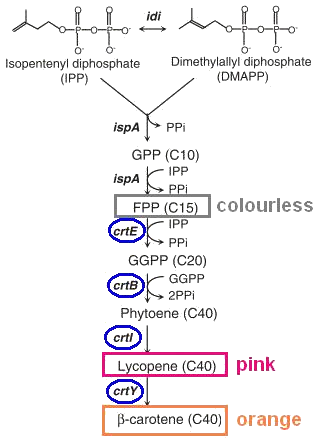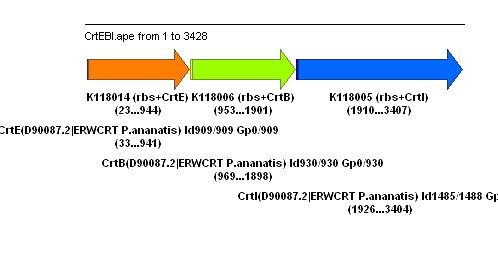Team:Cambridge/Project/Carotenoids
From 2009.igem.org
(→Test pigment production in E. coli MG1655) |
(→Test pigment production in E. coli MG1655) |
||
| Line 96: | Line 96: | ||
Certain strains of E. coli, e.g. MG1655, have been genetically engineered to up-regulate the enzymes involved in the pathway leading to FPP, thus increasing FPP supply and enhancing carotenoid synthesis. In ''Yuan et al.'', plasmid pPCB15 was used as reporter to assess the effect of such up-regulation. pPCB15 contains genes CrtEXYIB derived from ''Pantoea stewartii'' (homologous to the Biobricks available, which are derived from ''Pantoea ananatis'') and produces orange beta-carotene as the main coloured product. The results showed that upregulation of enzymes upstream of FPP led more beta-carotene production. | Certain strains of E. coli, e.g. MG1655, have been genetically engineered to up-regulate the enzymes involved in the pathway leading to FPP, thus increasing FPP supply and enhancing carotenoid synthesis. In ''Yuan et al.'', plasmid pPCB15 was used as reporter to assess the effect of such up-regulation. pPCB15 contains genes CrtEXYIB derived from ''Pantoea stewartii'' (homologous to the Biobricks available, which are derived from ''Pantoea ananatis'') and produces orange beta-carotene as the main coloured product. The results showed that upregulation of enzymes upstream of FPP led more beta-carotene production. | ||
| + | |||
| + | In our project, we wish to compare carotenoid pigment production in E. coli strains TOP10 and MG1655. Due to greater supply of FPP, we will expect higher level of carotenoid production in MG1655 than in TOP10. Working on MG1655 makes it easier to assess the effects of Biobricks on carotenoid synthesis, and allows us to develop and refine methods for pigment measurement and characterisation, which can then be applied on TOP10. | ||
== Construct composite Biobrick CrtEBI == | == Construct composite Biobrick CrtEBI == | ||
Revision as of 17:19, 29 July 2009
Categories :
Project :
-
Overview
Sensitivity Tuner
--- Characterisation
--- Modelling
Colour Generators
--- Carotenoids (Orange/Red)
--- Melanin (Brown)
--- Violacein (Purple/Green)
The Future
Safety
Notebook :
Team Logistics :
Carotenoid Pigment
Introduction
Carotenoids are organic pigments naturally present in plants, algae and some bacteria. There are more than 600 carotenoids, which can be categorised into xanthophylls (hydrocarbons containing oxygen element) and carotenes (hydrocarbons containing no oxygen). Carotenoids perform a range of functions, including light energy absorption, protection against photo-damage, acting as antioxidants, and as precursor to other organic compounds. In human, for example, beta-carotene is the precursor to vitamin A.
Part of the carotenoid biosynthesis pathway is shown below (figure adopted from iGEM 2007 Team Edinburgh):
Some of the intermediates in the above pathways are coloured, e.g. lycopene (red), beta-carotene (orange), and zeaxanthin (yellow). The enzymes involved in the biosynthetic pathway are CrtE, CrtB, CrtI, CrtY, and CrtZ. Since our team aims to use different colour pigments as signal output, the above pathway can be incorporated in our design of colour production.
Research by previous igem teams
A few iGEM teams of previous years (e.g. Edinburgh 07, Edinburgh 08, Guelph 08) conducted research in the carotenoid system. We are fortunate to have access to some of their Biobricks in the registry. Here is a summary of the Biobricks available:
| Registry Code | Team | Sequence Description | Notes |
|---|---|---|---|
| K118014 | Edinburgh 08 | rbs + CrtE | |
| K118006 | Edinburgh 08 | rbs + CrtB | |
| K118005 | Edinburgh 08 | rbs + CrtI | 2 PstI sites removed. |
| K118013 | Edinburgh 08 | rbs + CrtY | |
| K152005 | Guelph 08 | (rbs+CrtE) + (rbs+CrtB) + (rbs+CrtI) + (rbs+CrtY) + (rbs+GFP) | 2 PstI sites in CrtI removed. |
| I742158 | Edinburgh 07 | rbs + CrtZ |
The above enzymes all come from Pantoea ananatis (GenBank: D90087.2).
However, we have encountered certain issues during our preliminary research.
- In part K152005, the “CrtE” sequence (which originated from part K152001) contains 3 nucleotides different from the NCBI data base.
- Originally, the registry annotation for K152005 indicated that there was no ribosome binding site before gene CrtI (i.e. “…rbs+CrtB+CrtI+rbs+CrtY…”). After clarification with Team Guelph 08, we were told that it was solely an error in annotation. The registry entry for K152005 has been updated to the sequence in the table above.
- Teams of previous years constructed various composite parts containing two or more enzymes of the synthetic pathways (e.g. CrtEBI, CrtEBIY), but they were not available in the 2009 Distribution Plates.
Our Action Plan
In our project this year, we aim to incorporate the carotenoid biosynthesis pathway in E. coli and produce different coloured pigments. Potential candidates are lycopene (red), beta-carotene (orange), and zeaxanthin (yellow). Since these three compounds are sequential in the biosynthetic pathway, we hope to demonstrate colour changes from red to orange to yellow, by controlling expression of the enzymes involved in conversion.
Our action plan is as follows:
- 1. Test the activity of K152005 (CrtEBIY).
- 2. Test pigment production in E. coli strain MG1655 (up-regulation in precursors).
- 3. Construct composite biobrick containing CrtE, CrtB and CrtI (i.e. CrtEBI) and test its activity.
- 4. Transform E. coli with CrtEBI and CrtY. Test if activation of CrtY can cause colour changes in vivo.
- 5. Characterise our composite biobricks and the colour output.
- 6. Test compatibility with biobricks from previous iGEM teams and see if we can convert their outputs into pigment production.
Test activity of K152005
We wish to test the feasibility of incorporating the carotenoid biosynthetic pathway into E. coli, which does not produce carotenoids naturally. K152005 contains the enzymes for beta-carotene formation, and is a quick way to verify our concept.
We transformed E. coli (TOP10) using K152005 from the 2009 Distribution Plate (Week 2). After incubation for about 3 days, some light yellowish pigmention was visible. The long incubation time may be due to the fact that K152005 does not contain promoter. Although only small amount of yellow pigment was observed (instead of the expected orange colour), this gave us confidence that the carotenoid biosynthetic pathway was working in E. coli.
Mapping of Biobrick K152005 (update):
We will then put K152005 under a strong promoter (R0011, constitutive) to see if stronger colour production can be achieved.
Test pigment production in E. coli MG1655
The first compound in the carotenoid biosynthetic pathway, farnesyl pyrophosphate (FPP), derives ultimately from pyruvate and glyceraldehyde 3-phosphate (see figure on the right). The rate of carotenoid synthesis is limited by the rate of supply of FPP.
Certain strains of E. coli, e.g. MG1655, have been genetically engineered to up-regulate the enzymes involved in the pathway leading to FPP, thus increasing FPP supply and enhancing carotenoid synthesis. In Yuan et al., plasmid pPCB15 was used as reporter to assess the effect of such up-regulation. pPCB15 contains genes CrtEXYIB derived from Pantoea stewartii (homologous to the Biobricks available, which are derived from Pantoea ananatis) and produces orange beta-carotene as the main coloured product. The results showed that upregulation of enzymes upstream of FPP led more beta-carotene production.
In our project, we wish to compare carotenoid pigment production in E. coli strains TOP10 and MG1655. Due to greater supply of FPP, we will expect higher level of carotenoid production in MG1655 than in TOP10. Working on MG1655 makes it easier to assess the effects of Biobricks on carotenoid synthesis, and allows us to develop and refine methods for pigment measurement and characterisation, which can then be applied on TOP10.
Construct composite Biobrick CrtEBI
We wish to produce the first coloured compound in the pathway, lycopene (red), which can then be converted into other colours by subsequent enzymatic reaction.
In order to “pause” at lycopene, we need enzymes CrtE, CrtB and CrtI only. Currently in the registry there is no available Biobrick containing CrtEBI, so we decide to construct our own.
After transforming E. coli with K118014 (rbs+CrtE), K118006 (rbs+CrtB) and K118005 (rbs+CrtI), we construct composite biobrick by ligating the three genes together.
Plan mapping of CrtEBI:
Test colour changes by CrtY
Characterisation of Biobricks and colour output
Test compatibility with other biobricks
Reference
Nishizaki T, Tsuge K, Itaya M, Doi N, Yanagawa H. Metabolic engineering of carotenoid biosynthesis in Escherichia coli by ordered gene assembly in Bacillus subtilis. Appl Environ Microbiol. 2007 Feb;73(4):1355-61. PMCID: PMC1828653.
Luke Z. Yuan, Pierre E. Rouvière, Robert A. LaRossa and Wonchul Suh. Chromosomal promoter replacement of the isoprenoid pathway for enhancing carotenoid production in E. coli. Metabolic Engineering 8 (2006) 79-90.
Luan Tao, Raymond E. Jackson, Pierre E. Rouvière, Qiong Cheng. Isolation of chromosomal mutations that affect carotenoid production in Escherichia coli: mutations alter copy number of ColE1-type plasmids. FEMS Microbiology Letters 243 (2005) 227-233.
von Lintig J, Vogt K. Filling the gap in vitamin A research. Molecular identification of an enzyme cleaving beta-carotene to retinal. J Biol Chem. 2000 Apr 21;275(16):11915-20. PMID: 10766819.
 "
"



